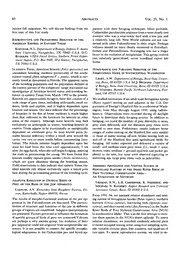
Reproductive and provisioning behavior of the American kestrel in eastern Texas PDF
Preview Reproductive and provisioning behavior of the American kestrel in eastern Texas
— 60 Abstracts VoL. 29, No. 1 We initiate fall migration. will discuss findings from the paratus with their foraging techniques. More probable, first year of this 2-yr study. Gathartidae peculiarities originate from a more closely tied ancestor who was a near-water bird with a low jaw and Reproductive and Provisioning Behavior of the a relatively long bill. New World vultures are not con- American Kestrel in Eastern Texas nected with other Falconiformes in their origin. Perhaps vultures should be more closely connected to Procellari- KoncHAR, N.L. Department ofBiology, Stephen F. Austin TX formes and Pelicaniformes. Scavenging was not a major State University, Nacogdoches, 75962 V.S.A. D.C. factor in the evolution of Accipitridae. This group evolved Rudolph. USDA Forest Service, Southern Forest Exper- iment Station, P.O. Box 7600, SFA Station, Nacogdoches, into relatively generalized, active woodland raptor life forms. TX 75962 U.S.A. In eastern Texas, American kestrels (Falco sparverius) are Home-RANGE and Foraging Behavior of the uncommon breeding residents presumably of the south- Ferruginous Hawk in Southcentral Washington reeansttleyrnlicsotaesdtaasl tphlraeiantseunbesdpienciFelsorFi.das..pTauhleusa,pwphairecnhtisracruirt-y Leary, A.W. Department ofBiology, Boise State Univer- sity, Boise, ID 83725 U.S.A. M.J. Bechard. Department of the breeding population and the population declines in ofBiology, Boise State University, Boise, ID 83725 U.S.A. the eastern portion ofthe subspecies’ range warranted our R. Mazaika. Battelle Pacific Northwest Laboratory, Port- investigation of American kestrel status and breeding be- OR land, 97232 U.S.A. havior in eastern Texas from March 1992 to the present. We Kestrels are opportunistic foragers; their diet consists of a studied movements of six adult male ferruginous hawks wide range of prey items, including arthropods, small ro- {Buteo regalis) nesting on and adjacent to the U.S. De- dents, birds and reptiles, and is highly dependent upon partment of Energy’s Hanford Site in southcentral Wash- location and season. Our data indicate that the percentage ington, from May through August 1994, using radiote- of hcrptiles in the diet of forest residents is much higher lemetry. Observations were recorded during all daylight than that indicated in the literature for kestrels in other hours to determine daily foraging activity. In addition to areas of the country. Although some kestrels may feed foraging, we noted the number of prey deliveries to nests, exclusively on arthropods in winter, breeding kestrels in prey sizes delivered, and the distances prey items were eastern Texas appear to be nutritionally or energetically carried to nest sites. Preliminary results indicate home dependent on vertebrate prey. In most kestrel pairs, fe- ranges of males nesting on the Hanford Site were similar males become sedentary within a small area around the to those of males nesting off-site. Males nesting both on cavity tree two or more weeks before commencing incu- and off of the Hanford Site used agricultural fields for bation. The female remains largely dependent upon her foraging. All males captured and delivered a variety of mate for food from this time until approximately 2 wk small- and medium-sized prey items (i.e., small = mice, aftertheeggs hatch, when she will begin foraging, assisting shrews, voles; medium = ground squirrels and pocket go- We the male in provisioning the young. have found that phers) to the nest, but none were observed capturing or kestrels readily capture green anoles (Anolis carolinensis), delivering any large prey items such as jackrabbits. which are quite abundant during the breeding season. Field observations to date indicate that eastern Texas res- Assessing Abundance and Nesting Success of ident kestrels rely almost exclusively upon a lizard prey Benchland Raptors in the Snake River Birds of base during the provisioning portion of the breeding cycle. Prey National Gonservation Area An Evaluation of Methods Adaptive Radiation in Diurnal Birds of Lehman, R.N., L.B. Garpenter, K. Steenhof, and Prey on the Basis of the Jaw Apparatus Michael N. Kochert. Raptor Research and Technical Ladygin, A.V. Kronotskiy State Biosphere Reserve, Eli- Assistance Center, Boise, ID 83702 U.S.A. zovo, Kamtchatka Region 684010, Russia From 1991-94, we assessed relative abundance and nest- The results of morpho-functional analysis of the jaw ap- ing success of ferruginous hawks {Buteo regalis), northern paratus in the Falconiformes are discussed. The particu- harriers {Circus cyaneus), burrowing owls {Speotyto cuni- larities of structure and functions of the jaw in different cularia), and short-eared owls {Asiafiammeus) in the Snake groups of raptors are considered. Adaptive interpretations River Birds of Prey National Gonservation Area (NGA) are presented. Factors perceived to influence the formation in southwestern Idaho. This was the first attempt to mon- of specific groups of birds of prey are presented.Vultures itor these species in the NGA’s desert uplands. To assess are perhaps a very ancient group, but evolution of their relative abundance, we searched randomly selected plots jaw apparatus could not originate from accipitrid-like an- to locate occupied nesting areas using four sampling meth- cestors. It is not possible to connect the specific morpho- ods: variable circular plots, line transects, and quadrats of logical adaptations in the Gathartidae jaw and hyoid ap- two sizes. To assess reproductive success, we tried to de-
